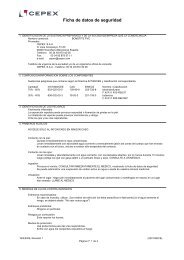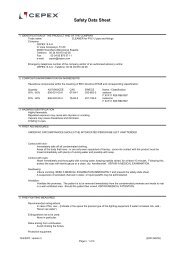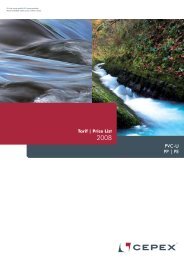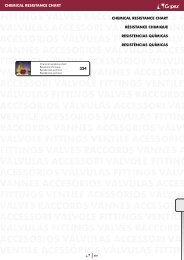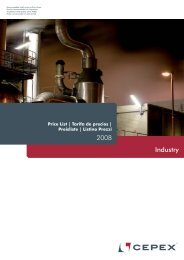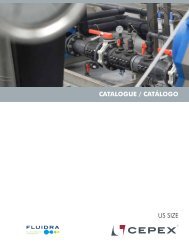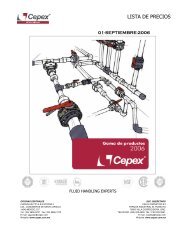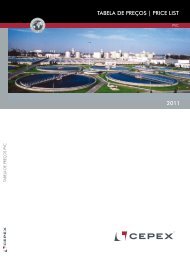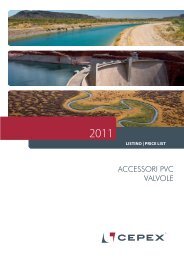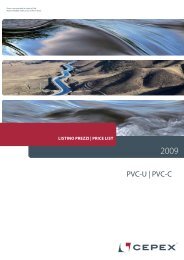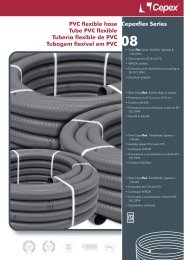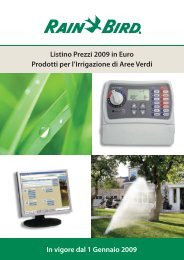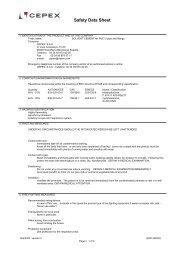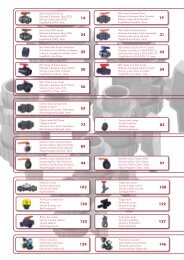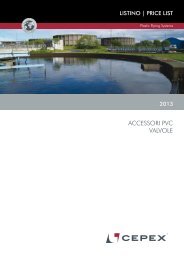PVC-U | PVC-C | PP | PE - Cepex
PVC-U | PVC-C | PP | PE - Cepex
PVC-U | PVC-C | PP | PE - Cepex
- No tags were found...
You also want an ePaper? Increase the reach of your titles
YUMPU automatically turns print PDFs into web optimized ePapers that Google loves.
A<strong>PP</strong>LICATION GUIDE GUIDE D’A<strong>PP</strong>LICATION GUIDA ALL’UTILIZZO<strong>PVC</strong>-U• Temperature range: 0°C to 60°C.• Abrasion resistant.• Non-toxic and taint free.• Rigid pipes: no special supportneeded.• Ideal for above and below grounduse.• Resistant to many inorganicchemicals.• Threading possible.• Resistant to most solutions of acids,alkalis and salts.• No special tools required forinstallation.• Jointing by cold solvent welding orrubber ring mechanical joints.• Not resistant to aromatic andchlorinated hydrocarbons (seechemical resistance chart for details).<strong>PVC</strong>-C• Temperature range: 0°C to 80°C.• Good mechanical strength.• Low thermal conductivity.• Odourless and tasteless.• Rigid pipes are suitable for aboveground use.• Resistant to many inorganicchemicals.• Threading possible.• No special jointing tools required.• Non flammable and selfextinguishing.• Not resistant to organic solvents (seechemical resistance chart for details).<strong>PVC</strong>-U• Plage de température: 0°C à 60°C.• Résistant à l’abrasion.• Non-toxique et non corrosif.• Tube rigide : pas de support spécialrequis.• Idéal pour utilisation en surface eten enterré.• Résistant à beaucoup de produitschimiques inorganiques.• Filetage possible.• Résistant à la plupart des solutionsacides, alcalines et salines.• Aucun outil spéciaux requis pourl’installation.• Raccordement par raccords à collerou joint hydraulique.• Non résistant aux hydrocarburesaromatiques et chlorés (voir lediagramme chimique de résistancepour des détails).<strong>PVC</strong>-C• Plage de température: 0°C à 80°C.• Bonne force mécanique.• Basse conductivité thermique.• Inodore et sans goût.• Recommandé pour installation enextérieur.• Résistant à beaucoup de produitschimiques inorganiques.• Filetage possible.• Aucun outil spéciaux requis pourl’installation.• Ininflammable.• Non résistant aux dissolvantsorganiques (voir le diagrammechimique de résistance pour desdétails).UNIONS UNIONS UNIONICement jointing• Solvent cement acts as a weldingagent (without the need for heating)between two surfaces and alsoacts as an insulator from chemicalsubstances, electricity, etc. It does notapply zone tension (as it happens withbolts, for example).• Tools needed: pipe cutter, beveler,cleaner, solvent cement and a tool toapply the adhesive (e.g.: brush).• See minimum amount of glue foreach size.• Properly bevel the pipe as indicatedin order to prevent the glue fromcoming out when the pipe is insertedinto the fitting.• It is important to clean up thesurfaces in order to avoid defectivecontacts.• Surfaces must be dry and untouchedwhen applying the solvent cement.• Watch for the allowed temperatureswhen cementing, as they will beimportant for the coefficient ofexpansion. Protect the union fromsunlight.• Respect the drying times andpressure to apply.Threaded unions• Union is achieved without the needfor special tools.• Do not use when the system has tostand significant torsion force.• Do not force the thread.• It is recommended to reinforce onlywith PTFE (Teflon ® ) tape, as it will offergreater watertightness.• Threads can come with metalreinforcement rings.• In <strong>PVC</strong>-U with metal unions, use<strong>PVC</strong>-U as the male.Other possibilities are explained ineach corresponding chapter (rubberring joint, flanges, unions).Raccords union à coller• La colle agit comme une soudureà froid entre deux surfaces et sontaislantes substances chimiques,électricité, etc. Ils n’appliquent pas unetension zonale (comme les vis, etc.).• Outils nécessaires : coupe-t- destubes, chaflanador, nettoyeur, adhésifet aplicador.• Voir minimale quantité de colle pourchaque diamètre.• Chanfreiner bien le tube selondes spécifications, pour éviter ledécollement de colle en insérant letube dans l’accessoire.• Important celui nettoyé de surfacespour éviter des contacts défectueux• Les surfaces doivent être sèches etsans toucher quand appliquera-t-illa colle.• Observer les températures permisesen collant, importantes par lecoefficient de dilatation postérieure etde protéger l’union de rayons solaires.• Respecter des temps séché et de lapression appliquée.Unions filetées• Union sans avoir besoin d’aucunoutil spécial.• Ne pas utiliser quand le systèmedevra supporter beaucoup de forcede torsion.• Ne pas forcer la spirale.• Le renforcement seulement avecruban de PTFE est recommendable(Teflon ® ) puisqu’offrira-t-il une plusgrande étanchéité.• La spirale peut avoir renforcementmétallique.• Dans des unions <strong>PVC</strong>-U avec métal,le mâle doit être le <strong>PVC</strong>-U. D’autrespossibilités sont expliquées dans lesparagraphes correspondants (unionpar ensemble élastique, desbrides, 3 pièces).<strong>PVC</strong>-U• Rango di temperature: 0°C a 60°C.• Resistente all’abrasione.• Non tossico ed esente dacorrosione.• Non è richiesto un supportoparticolare per il tubo rigido.• Ideale per installazioni esterne odinterrate.• Resistente ad una gran varietà disostanze chimiche inorganiche.• Possibilità di unioni per filetto.• Resistente alla maggior parte dellesoluzioni acide, alcaline o saline.• Per la sua installazione non sonorichiesti attrezzi speciali.• Unioni con adesivo o unioni conguarnizione elastica.• Non resistente ad idrocarburiaromatici o clorinati (si vedano letabelle delle resistenze chimiche).<strong>PVC</strong>-C• Rango di temperature: 0°C a 80°C.• Buona resistenza meccanica.• Bassa conduzione termica.• Inodore e insapore.• Tubazione rigida raccomandata perinstallazioni fuori terra.• Resistente a molte sostanze chimicheinorganiche.• Possibilità di unioni per filetto.• Per la sua installazione non sonorichiesti attrezzi speciali.• Non infiammabile edautoestinguente.• Non resistente a solventi organici(si vedano le tabelle delle resistenzechimiche).Unioni ad incollaggio• Gli adesivi realizzano la saldatura(senza necessità di calore) tra duesuperfici e sono isolanti di sostanzechimiche, elettricità, ecc. Non creanotensioni zonali (come le unionibullonate, ecc.).• Attrezzi necessari: tagliatubo,smussatore, solvente, collante eapplicatore.• Vedere la minima quantità di collarichiesta per ogni diametro.• Smussare bene il tubo secondospecifiche, per evitare lo spreco dicollante nell’inserimento del tubonell’accessorio.• E’ importante la pulizia dellesuperfici per evitare unioni difettose.• Le superfici devono rimanereasciutte e non devono essere toccateprima dell’applicazione del collante.• Rispettare le temperature richiesteper l’incollaggio importanti peril coefficiente di dilatazione eproteggere l’unione dai raggi solari.• Rispettare i tempi di asciugatura infunzione della pressione da applicare.Unioni a filetto• Unioni senza la necessità di nessunattrezzo speciale.• Non utilizzarle quando il sistemadebba sopportare elevate forzetorsionali.• Non forzare il filetto.• E’ raccomandabile solo l’utilizzo dinastro in PTFE (Teflon ® ) che offrirà unamaggior tenuta.• Il filetto può avere un rinforzometallico.• In unioni <strong>PVC</strong>-U con metallo, ilmaschio deve essere il <strong>PVC</strong>-U.Altre possibilità si ottengono con unionidifferenti (unioni con guarnizioneelastica, flange, bocchettoni).11<strong>PVC</strong>-U• Temperaturbereich: von 0°C bis60° C.• Abriebfest.• Ungiftig und korrosionsfrei.• Für Hartrohre kein Spezialwerkzeugerforderlich.• Ideal für über- und unterirdischeInstallationen.• Beständig gegen viele anorganischeChemikalien.• Gewindeverbindungen möglich• Beständig gegen viele Säure-,Alkali-, und Salzlösungen.• Für Installierung keinSpezialwerkzeug erforderlich.• Nicht resistent gegen aromatischeund chlorierte Kohlenwasserstoffe(siehe Beständigkeitstabelle).<strong>PVC</strong>-C• Temperaturbereich: von 0°C bis80° C.• Hohe mechanische Festigkeit.• Niedriges Wärmeleitvermögen.• Geruchs- und geschmacksneutral.• Hartrohre sind geeignet fürüberirdische Verlegung.• Beständig gegen viele anorganischeChemikalien.• Gewindeverbindungen möglich.• Keine Spezialwerkzeuge erforderlich• Nicht entflammbar undselbstlöschend.• Nicht resistent gegenOganische Lösungsmittel (sieheBeständigkeitstabelle).AnwendungSbereichVerbindungsmöglichkeitenKlebeverbindungen• Wie bei der Schweißtechnik (Erwärmennicht notwendig) wirken Klebstoffe zwischenzwei Oberflächen und sind wie eineIsolierung vor chemischen Substanzen,Elektrizität usw. Es entsteht auch keineZonenspannung (wie z. B. bei Schrauben,usw.).• Nützliche Werkzeuge: Rohrschneider,Entgratungsgerät, Reiniger, Kleber undPinsel.• Siehe angemessene Klebstoffdosierungfür jeden Durchmesser.• Das Rohr ordnungsgemäß anfasen, umein Austreten des Klebstoffes zu verhindern,wenn das Rohr in die Muffe geführt wird.• Wichtig die Oberflächenreinigung, ummangelhafte Verbindungen auszuschließen.• Die Oberflächen müssen trocken seinund nicht mit den Händen berühren,sobald der Kleber aufgetragen werden soll.• Wegen des möglichen Ausdehnungskoeffizientendie empfohlenen Außentemperaturenbeim Kleben beachten.Verbindung vor Sonneneinstrahlungschützen.• Zeit für das Trocknen einhalten undentsprechend Andrücken.Gewindeverbindungen• Kein Spezialwerkzeug erforderlichNicht bei Anlagen einsetzen, die starkenTorsionskräften ausgesetzt sind.• Die Muffe nicht mit Gewalt eindrehen.• Es wird empfohlen nur PTFE (Teflon ® )–Band zum Abdichten verwenden, umhöhere Dichtigkeit zu gewährleisten.• Die Gewindemuffe kann einenVerstärkungsring aus Metall haben.• Bei <strong>PVC</strong>-U mit Metallverbindern, solltedas <strong>PVC</strong>-U das Außengewinde haben.Andere Möglichkeiten werden in denentsprechenden Kapiteln (Verbindungen mitHilfe von Gummidichtringen, Flanschen,Verschraubungen) erläutert.



